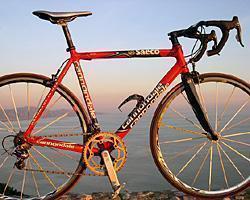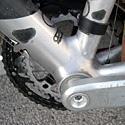
| Team Tech |
| 2004 Teams Database |
| Road Season Preview 2004 |
Recently on Cyclingnews.com |
Pro Team Tech 2004
Cannondale's carbon/aluminium bike official
From Tech News, February 11, 2004

|
At the Saeco training camp in Italy over the weekend, Cannondale officially launched the carbon fibre and aluminium bike that Saeco will campaign this year, as the red coffee machine team aims to defend Gilberto Simoni's Giro title and make more of an impact at the Tour de france this year than last.

|
Dubbed the six13, for the atomic numbers of carbon and aluminium respectively, the new bike is constructed from custom carbon fiber tubes bridging welded aluminium lugs and the bare frame is claimed to weigh 1,150 grams.
Now, slipping carbon fiber tubes into metal lugs isn't exactly a new notion, as some readers pointed out when we looked at the prototype six13s Saeco were riding at last year's Tour, but Cannondale claims to have come up with some finessing of the idea that gives real advantages.

|
For starters, the tubes are formed in place within the lugs, so there's a mechanical interface between the two, and the joint isn't just relying on adhesive to hold it together. Terrific as modern glues are, you do now and then hear of bonded frames failing at the joints. Cannondale also claims that this makes for a stiffer joint and therefore a stiffer frame.
Cannondale describes its carbon fiber tubes as 'braided' rather than woven, and claims this allows customization of tube shapes and variable wall thicknesses.
Perhaps the biggest advantage of this construction, though, is that Cannondale plans to offer 12 different frame sizes when the six13 becomes available in April. That's a respectable range, and should allow most riders to get a decent fit, addressing the most common complaint about composite bikes that the restricted range of frame sizes makes precise fitting difficult.
Photography
Images by Tim Maloney/Cyclingnews
- Cannondale's 2004 six13 Saeco team bike - almost floating away in the evening sunshine
- Carbon weave visible on the main tubes of the Saeco six13s
- Saeco Cannondale six13 drivetrain - Cannondale Hollogramcranks, Campagnolo derailleurs, Mavic Ksyrium wheels & Time pedals
- Carbon peek-a-boo - the six13's carbon tubes peek through the paint
- More carbon: FSA's K-Wing carbon fibre handlebar is the cockpit for the 2004 Saeco team Cannondale six13
- A Saeco 2003 team bike showing the intermingling of tubes and lugs at the head cluster
- Welded bottom bracket & seatstays with carbon down tube
